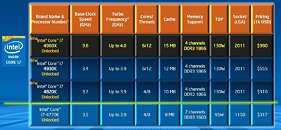Tuesday, September 3rd 2013

Intel Core i7 "Ivy Bridge-E" HEDT Processors Start Selling
Intel made its newest Core i7 high-end desktop (HEDT) platform official with the launch of three new socket LGA2011 processors based on the swanky new 22 nm "Ivy Bridge-E" silicon. The launch includes the top-end Core i7-4960X Extreme Edition, priced at $990, followed by the Core i7-4930K at $555, and Core i7-4820K at $310. Expect a 10 percent markup across the board for these prices. Of these, the i7-4960X and i7-4930K are six-core parts, while the i7-4820K is quad-core.
The Core i7-4960X features a CPU clock speed of 3.60 GHz, with up to 4.00 GHz Turbo Boost frequency, 15 MB of L3 cache, and HyperThreading, which enables 12 logical CPUs for the OS to deal with. The i7-4930K clocks in at 3.40 GHz, with up to 3.90 GHz Turbo Boost, 12 MB of L3 cache, and HyperThreading. The i7-4820K, at its price point, can be extremely inviting for people with their minds set on a Core i7-4770K. It features 3.70 GHz clocks with up to 3.90 GHz Turbo Boost, 10 MB of L3 cache, and HyperThreading, enabling 8 logical CPUs. All three parts feature quad-channel DDR3 integrated memory controller with native support for DDR3-1866, 48-lane PCI-Express gen 3.0 root complexes, and 130W rated TDPs.
The Core i7-4960X features a CPU clock speed of 3.60 GHz, with up to 4.00 GHz Turbo Boost frequency, 15 MB of L3 cache, and HyperThreading, which enables 12 logical CPUs for the OS to deal with. The i7-4930K clocks in at 3.40 GHz, with up to 3.90 GHz Turbo Boost, 12 MB of L3 cache, and HyperThreading. The i7-4820K, at its price point, can be extremely inviting for people with their minds set on a Core i7-4770K. It features 3.70 GHz clocks with up to 3.90 GHz Turbo Boost, 10 MB of L3 cache, and HyperThreading, enabling 8 logical CPUs. All three parts feature quad-channel DDR3 integrated memory controller with native support for DDR3-1866, 48-lane PCI-Express gen 3.0 root complexes, and 130W rated TDPs.

36 Comments on Intel Core i7 "Ivy Bridge-E" HEDT Processors Start Selling
Everyone seems to forget that 2011 falls under the server market more than anything else and that the i7s on 2011 are just stripped down Xeons. :banghead:
These hexas are much more better than 1150s quad when you use all of 12 threads.
You being content with the 4770k means you didn't need 6 cores to begin with :toast:
There are some benefits of the new Ivy Bridge-E but I think its important to note that there is a hidden benefit (or at least one that many are not acknowledging). That is to say that Intel has provided an upgrade path as an option on a well established platform before moving on to said platforms successor. A nicety that I think many like to have as an option even if they chose not to take advantage of it.
Personally I think the LGA2011 platform has held up extremely well in general as well as for its age. Understanding the platform and its use case is key though and I don't think a lot of people get it.
This is business as usual and the pricing scheme is in line with its predecessor. Haswell-E will likely be no different in its relative trifecta offerings and pricing scheme.
Haswell-E will presumably be on an LGA2011-3 socket with the same pin count as the current LGA2011 socket. The same people complaining about Ivy Bridge-E now are likely the same people that will complain about Haswell-E requiring a new socket, chipset and motherboards,.....but still retaining the same pin count.
Why complain about something like a platform or segment of the market (like HEDT) that you're never going to buy into anyway,.....?
The extreme series is a low yield high margin part one would think which tapers off with the middle and entry level processors. Intel already likely expect lower sales numbers accordingly just as they did for Sandy Bridge-E.
When you think back to Bloomfield and the LGA1366 platform one can point to Gulftown and say there were significant upgrade options before the platform was superseded. While true most Gulftown processors were well out of the price range of people looking to upgrade at ~$1000 or so. Even today a Core i7 975 or 970 will cost in the ~$700+ range. So I think its noteworthy that Intel is providing high-end options and processor refreshes for LGA2011 in a more palatable price range (~300 to ~1000 rather then ~$700 to ~$1000).
People arguing against such an upgrade option are also coming close to making the point that perhaps processors should be soldered to the motherboard. After all, no one wants an upgrade option anyway,....right!?!
Also as you said not everyone is upgrading so the performance delta between Sandy Bridge-E and Ivy Bridge-E isn't necessarily an issue (for some) anymore then the performance delta between Sandy Bridge and Ivy Bridge or Haswell is an issue for those on an older platform. There are also power savings to consider / calculate.
If a platform isn't for you (your use case) then I see nothing wrong with acknowledging that fact but its quite another thing to suggest it shouldn't even exist simply because its wasn't designed for your specific use case.
who are the foreign literature who studies the i7 processor??
please..??
Or the celebration party at least...